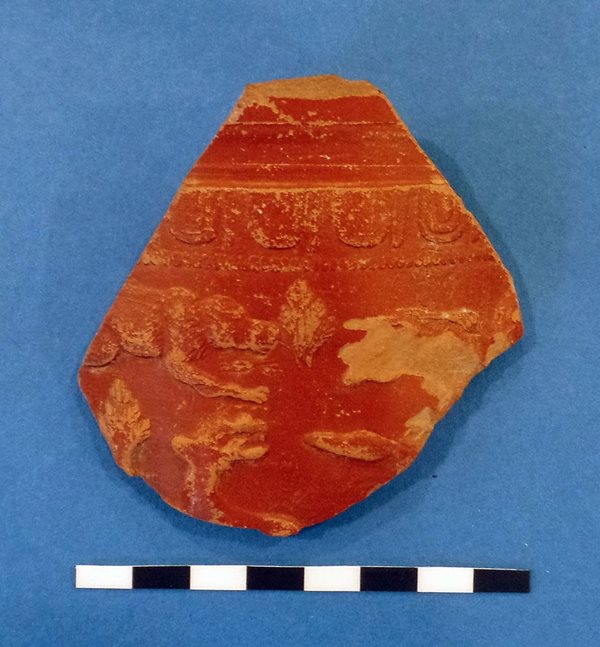First century BC to the third century AD
Roman Samian Ware
From Lagore Crannog, Co. Meath.
By Leo McNameeRoman Material in Ireland
"More of Britain would be prosperous if Roman forces were everywhere and freedom was taken out of view". Tacitus (Agricola, 24)
This was the opinion of Tacitus, a Roman historian writing at the end of the first century AD, who viewed Ireland as a safe haven for troublesome British tribes. Ireland never was conquered by the Romans but trade between the two was common. This is evident in the archaeological record with Roman artefacts found in numerous sites around Ireland.
The Museum has a collection of Roman pottery from Ireland, England and elsewhere in mainland Europe. These three small sherds of Samian ware (E14:218-220) were found during excavations at Lagore Crannog, County Meath, between 1934 and 1936. The fabric of the pottery is orange-pink in colour and the slip is orange-red. All three are decorated body sherds. Fine horizontal grooves formed by the potter’s fingers are visibly on the interior surface of smallest sherd (E14:218). One of the sherds (E14:220) has traces of wear and has been perforated, possibly for later re-use as a pendant.
Other Roman artefacts found north of Dublin, including coins and brooches, led to speculation that the Romans may have sent a force to Ireland. Indeed, Tacitus was in favour of annexing Ireland saying that “Ireland is positioned between Britain and Spain and is easily accessible from the seas around Gaul. It would unite the strongest parts of our Empire with great mutual advantage.” However, events on the continent and a war in Dacia (modern day Romania) meant an invasion of Ireland never happened but trade did exist. Ireland exported food and animal hides to the Roman world in exchange for luxury items including jewellery and glassware.

Trade between Ireland and Rome continued into the early medieval period with sherds of Samian ware found during the excavations of Viking Dublin, most likely brought back to Ireland by pilgrims as keepsakes. Indeed, it is likely that these three sherds from Lagore were also brought back to Ireland in a fragmentary state in the post-Roman period; the perforated sherd suggests it may have been taken as a souvenir and worn as a pendant. Samian ware sherds from Dalkey Island also appear to have been deliberately cut adding weight to this argument.
Samian Ware
The technology of ceramic production was highly developed by the Roman period and sophisticated techniques allowed for the efficient production of standardised vessels. Pottery could be made anywhere that suitable clay was found and was used in large quantities throughout the Roman Empire. Roman pottery was used for the storage, preparation and cooking of food as well as for serving food at the dining table. Most pots were multi-purpose and could be designed for one use and then later re-used for something else.
Samian ware (Terra sigillata) is the name given to red-gloss pottery that was mass-produced from the first century BC to the third century AD. It was first produced in northern Italy but by midway through the first century AD it was nearly all being made in Gaul with some small scale production in Colchester in Roman Britain. Distinguished by its red colour, Samian ware is often elaborately decorated with typical classical scenes from mythology. Bowls, dishes, plates and small cups with decoration in relief were made by throwing the pot within a mould. Decoration could also be applied freehand and some potters signed their names onto the vessels. The shapes and sizes of Samian ware vessels were very standardised and similar in design to silver and glass tableware. Examples of Samian ware have been found as far afield as the eastern empire.

Learn More
These sherds of Roman Samian ware are part of the museum’s reserve collection and are not currently on display. However, there are some sherds from Viking Dublin on display in the National Museum of Ireland’s Viking exhibition.
References
Comber, M. (2001) "Trade and Communication Networks in Early Historic Ireland", The Journal of Irish Archaeology, 10, Wordwell Ltd.
Hencken, H. (1950) “Lagore Crannog: An Irish Royal Residence of the 7th and 10th Centuries AD”, PRAI 53C
Lynn, C. (1984) "Some Fragments of Exotic Porphyry found in Ireland", The Journal of Irish Archaeology, 2, Wordwell Ltd.
Mulvin, L. (2006) Roman & Byzantine Antiquities in the National Museum of Ireland – A Select Catalogue, Wordwell Ltd.
Warner, R.B. (1976) “Some observations on the context and interpretation of exotic material in Ireland, from the first century BC to the second century AD”, PRAI 76C
www.irisharchaeology.ie/2011/11/roman-contacts-with-ireland/
Suíomh:
Roman Samian Ware suite ag:
In Storage
An déantán roimhe seo:
An chéad déantán eile:
Rule Book for the Rural Postman
